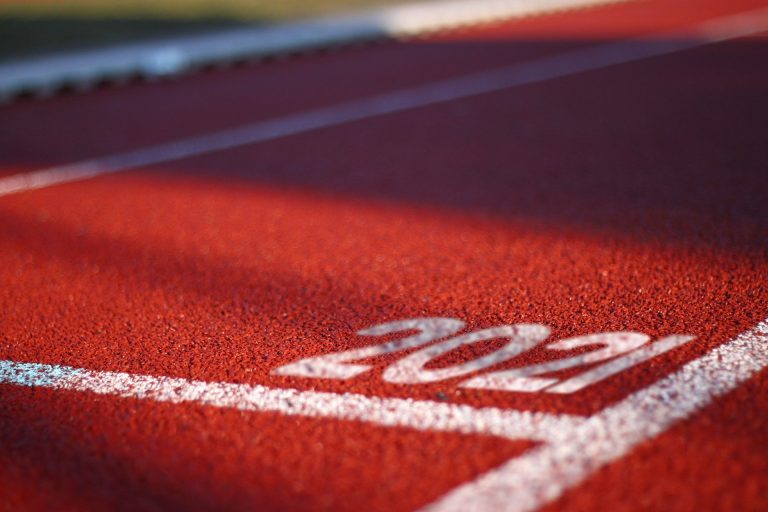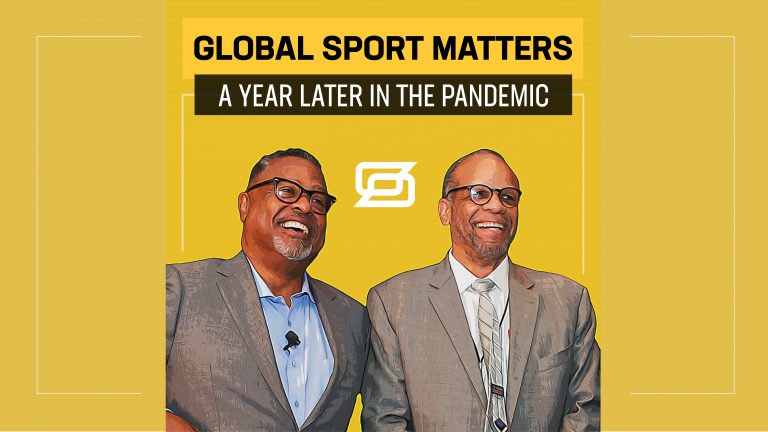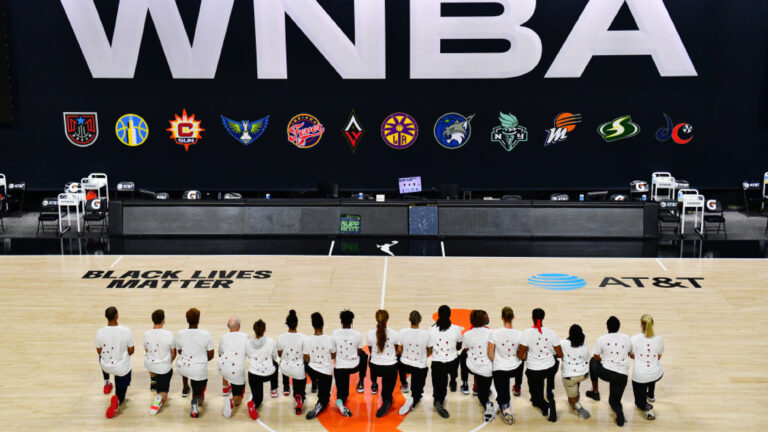One Year Later: How COVID-19 Drove and Accelerated Change in Sports – and Beyond
Why this matters
Altered and politicized, sports during the pandemic have been a funhouse mirror of a nation in crisis – divided and contested, determined to push through, and perhaps emerging forever changed.
On February 2, 2020 – the last Groundhog Day before every day began to feel like Groundhog Day – Super Bowl LIV went on as planned. At that moment, 11 people across the country were known to be infected with the largely mysterious virus known as COVID-19; not a single American had died from it. In Miami, the site of the game, officials calmly noted that while the Centers for Disease Control and Prevention had begun screening travelers for the virus, the city’s airport was not receiving some sort of dedicated quarantine station.
This, of course, was in the before times, when the grim reality about to unfold was almost incomprehensible, like something out of a Hollywood thriller. We didn’t yet know how many lives would be lost or how much everyday life would be upended and smothered by constant and dreadful calculations of risk.
Instead, we watched the game. Midway through the fourth quarter, with the Kansas City Chiefs trailing the San Francisco 49ers 20-10 and seemingly headed to defeat, Chiefs quarterback Patrick Mahomes threw a 44-yard strike to wide receiver Tyreek Hill, a play that completely reversed the game's momentum. In the moment, it was the most important pass of Mahomes’ career, one that sparked the Chiefs to a comeback victory.
In retrospect, it was likely bigger still. With a single single flick of his arm, Mahomes unwittingly may have saved hundreds of lives.
The theory, first put forward in a Wall Street Journal article, goes like this: The Chiefs’ subsequent victory parade, held in Kansas City, did not become a COVID-19 super-spreader event because the virus had yet to reach the Midwest. But a raucous 49ers victory parade – held on Market Street in the center of one of America’s most vibrant cities – would have almost certainly included several people who were infected with COVID-19, even if they didn’t know it yet.
Those people, screaming and yelling and hugging and crying, drinking and eating and celebrating together in bars and restaurants, would have spread it to dozens of others, who would have spread it to dozens more, because the virus already was circulating in the Bay Area as early as late January.
“[That] could have been a huge amplifying event,” says George Rutherford, the director of the Prevention and Public Health Group at the University of California, San Francisco. “It could have very easily been a big deal.”
Over the course of the next year, Americans wouldn’t remain so lucky. Nor would our sports. Postponed, canceled, altered, and politicized by a pathogen transported from a faraway province in a faraway country, the games we play became a funhouse mirror of our national crisis – and of the changes it made possible. “The phrase I heard was that the pandemic was an accelerant,” says Tolga Ozyurtcu, an assistant professor at the University of Texas who focuses on sport and physical culture. “And we saw a pandemic acceleration in the sports world, as well.”
As sport became further polarized, perspectives shifted
From the start of the pandemic, it was impossible to separate sports from larger debates about risk and reward, personal freedom and social responsibility, saving lives and saving livelihoods. Did sports matter enough that they should go on, even in a time of severe societal stress? Did they matter less than we think? Were they, as writer Jane McManus said – with a quote that then-Washington Nationals pitcher Sean Doolittle later amplified – “the result of a functioning society, and not the precursor?”
Just two weeks after the Super Bowl, a Champions League soccer match in Milan that hosted 40,000-some Italian and Spanish fans became known as “Game Zero” for the way it seemed to spark a COVID-19 outbreak among players, journalists, and other people in both countries. This was the nightmare scenario. Yet as Europe locked down, American sports kept charging forward – until denial was no longer viable. On March 10, 2020, after the Ivy League canceled its postseason basketball tournament, Harvard University basketball player Bryce Aiken tweeted, “Horrible, horrible, horrible decision.”
The next day, Utah Jazz center Rudy Gobert tested positive for COVID-19. The National Basketball Association suspended its season. March Madness was canceled. Hockey stopped. Baseball didn’t start. The country began a series of intermittent lockdowns. And things began to accelerate. We grappled with whether sports should be played; how and where they should be played; and why and how athletes should embrace the risk of playing. Our schools and businesses wrestled with the same questions. So did our state houses and houses of worship.
Answers proved difficult – and contentious. In the three years preceding the arrival of COVID-19, the then-president of the United States, Donald Trump, had made it clear that he was willing to politicize every aspect of American life, including sports. This brought a counter-movement of athletes who were no longer willing to remain silent, and their protests began to dovetail with larger issues that had been percolating: the links between police mistreatment of racial minorities and the silent protest of Colin Kaepernick in support of Black Lives Matter.
The perpetual question of whether (and how) college athletes should be paid. Arguments over whom the law protects and whom it binds; over who gets what under what rules; over whose needs and identities are considered central to the American project and whose are not. The pandemic acted like a foot on a gas pedal. With no games to play and plenty of time to think, many athletes, particularly those of color, began to ask: what is my role in those arguments? In advocating for social justice?
Eventually, sports resumed – carefully, cautiously, in fits and starts, with COVID-19 protocols and without fans in the stands. From the standpoint of salvaging lost television revenue while preventing a viral outbreak, the NBA bubble in Orlando, Florida, was a remarkable success. But it also required extended physical isolation from the wider world, from family and friends and any semblance of normalcy.
Like all of the tradeoffs being made between safety and commerce, big and small and in every corner of the country, it was draining and depressing. When George Floyd’s murder galvanized so many, athletes became one of the primary conduits for expressing horror and sadness, anger and a pent-up desire for meaningful change.
Within the NBA bubble, a one-day boycott dominated the national conversation; inside and outside the Women’s National Basketball Association bubble, a player rebellion against a Republican senator who also was a part-owner of a team may have directly led to her getting voted out of office – in turn flipping control of the Senate to the opposing party, altering the entire range of national political possibilities for at least the next two years.
The pushback to this pandemic-enhanced wave of athlete activism was sometimes fierce, rooted in the ever-present notion that athletes should just shut up and play – that sports should be a respite from the real world. An emotional safe space. A bubble of a different kind. Why, some wondered, should we have to view everything through the prism of activism? Why can’t we just enjoy something in this otherwise dire moment?
For opportunistic conservative talkers, and for the president himself, sports became a useful cudgel, a handy metaphor for the political battles raging over the restrictive public health measures enacted to fight the virus, and when and how to resume business as usual. Canceling games meant you lived in fear. Canceling games meant you might as well have been canceling America itself. And, of course, there was money at stake for those with an investment in sports; there was capitalism at stake.
For the president – who advocated repeatedly for the return of Big Ten football in the fall of 2020 and then wrongfully took credit for its eventual return – there were swing states to be won in the upcoming election. Even the debate over mask-wearing had echoes in sports’ endless arguments about what constitutes toughness.
'I'm not sure anybody wants to do this again'
Rutherford, the public health expert, wasn’t surprised by the yearning for sports, even as coronavirus cases and deaths surged. Before becoming a doctor, he played tennis for Stanford University, where he also majored in classics. The two things that kept Roman emperors safe in times of trouble, he says, were “bread and games. People want to be entertained, and they want to be fed.”
And so the show went on. The National Football League played a full fall season, providing valuable content to television networks and the CDC alike. College football stumbled through a series of delays and cancellations and infections and even one virus-related player death; despite those costs, the sport did not forsake the roughly $500 million payout that came from staging its playoffs. And maybe this was predictable.
At moments of crisis in America, sports have always served as a measure of mood, our willingness or reluctance to function amid tragedy – from the 1918 World Series concluding amid the dark clouds of a world war and Spanish flu to the NFL postponing its games in the wake of the Kennedy assassination to the New York Yankees playing the World Series in the weeks after the Sept. 11, 2001, terrorist attacks.
“Historians who study that pandemic look at it as a failure of leadership.” - Johnny Smith
Throughout the 1918 pandemic, says Johnny Smith, as associate professor of history at Georgia Tech University and co-author of the book War Fever, a number of sporting events went on anyway in entirely haphazard fashion. He points, in particular, to a photo of Georgia Tech fans at a football game in the fall of 1918, their faces covered in masks. “When it came to a sport like college football, there was no organization or coordinated response that I’m aware of,” Smith says. “Historians who study that pandemic look at it as a failure of leadership.”
More than a century later, the college football season ended with 139 games being canceled on the Football Bowl Subdivision level and an exhausted sigh of relief that things weren’t worse. “If we had to go through this again and do it again, I’m not sure everybody is signing up,” one major college athletic director told Sports Illustrated. “I’m not sure anybody wants to do this again.”
Sport went bust in 2020, could a boom be next?
Even now, as we wearily approach what appears to be the homestretch of a horrific period, sports remain a mirror. Stadiums and arenas have become mass vaccination sites – including Hard Rock Stadium in Miami, where Mahomes threw his fateful pass. Meanwhile, coaches in nearly every sport are constantly pulling down their masks to scream at their players, in both deliberate and incidental acts of defiance. “I wish the coaches could have set better examples,” Rutherford says.
What happens next? As a society, we’re becoming more aware of how disease can spread, particularly in public places like stadiums. That means more touchless mustard dispensers, more hand-sanitizing stations, more options to order concessions through your smartphone rather than clogging up concourses.
Away from arenas, it could mean more working from home, more living through screens, and more digitization of shopping and medicine and watching movies and everything else that can be done without coming together. Now that people have gotten used to wearing masks, they might also be willing to wear them more often in crowded spaces, particularly if they’re sick. “That’ll become sort of a social norm, I would hope,” Rutherford says.
In the wake of the 1918 flu pandemic, Smith says, sports entered an era of “hyper-commercialization.” Embracing the rise of mass media like radio, newspapers, and magazines, a number of colleges built huge stadiums to accommodate large crowds; amid a decade of conspicuous consumption, athletic celebrities like boxer Jack Dempsey became larger-than-life figures. Maybe that sort of post-crisis sports boom, powered by a broader economic rebound, could happen again.
Women college athletes, for instance, could use social media and the newly won ability to market their names, images, and likenesses to grow their sports and clout by connecting with a new generation of fans. Superstars like the NBA’s LeBron James could continue to build power and influence by putting money and energy into business and entertainment ventures; some could even end up in politics.
Alternately – as the virus is contained and society settles into a new normal – there could be countervailing pressure within sports to move back toward enjoyment and escape and away from social activism or anything else considered controversial. “I don’t know if we should expect to see radical changes,” Ozyurtcu says, “other than the simple fact that the last year was a reminder that change is possible.”
And also ongoing. Recently, legislators in Georgia – the same state where WNBA players proved so politically potent – enacted new and restrictive voter laws that our new president, Joe Biden, likened to “Jim Crow in the 21st Century.” In response, Major League Baseball pulled its All-Star Game from Atlanta, reportedly after lobbying from civil rights groups and discussions with players. Traditionally, wrote The Washington Post, “baseball has avoided placing itself at the center of politicized issues,” but that simply wasn’t a palatable option.
Not anymore. One year later, the pandemic continues to be a powerful accelerant.
Monthly Issue
Now & Then: How Sport Has Transformed
For many, it’s been approximately a year in the life of a pandemic. We’ve seen tragedy, resilience, growing gaps of opportunity and opportunities for growth, juxtaposed in communities across the globe. The world of sport was not immune.
From a pause in play, to a push for more progressive racial justice, to unanswered questions about the long-lasting impacts of COVID-19 that still linger in the air - what do we wish we knew then, that we know now?





